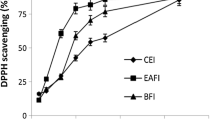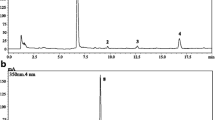Abstract
The hydro-alcoholic extracts of five Equisetum species, E. arvense L., E. sylvaticum L., E. fluviatile L., E. palustre L. and E. telmateia Ehrh., growing-wild in Serbia were evaluated for their genotoxicity, antimicrobial activity, antioxidant capacity and the results related to the total phenol content and HPLC flavonoid profiles. The total phenol content was 92–349 μmol expressed as equivalents of chlorogenic acid per g of dried plant material. Main identified compounds were kaempferol-, quercetin- glycosides and caffeic acid derivatives. E. telmateia extract showed the greatest antioxidant capacity. Almost all tested microorganisms demonstrated some degree of sensitivity to the examined extracts. All tested extracts at 62.5 μg/ml showed higher incidence of micronucleus formation than in the control sample. The obtained data allowed mutual comparison of examined species and their assessment as possible sources of antioxidants, antimicrobials and/or genotoxic substances.
Similar content being viewed by others

References
Vukićević E (1992) Rod Equisetum L. In: Sarić M (eds) Flora Srbije, 2nd edn. SANU, Beograd, pp 84–92
Nagai T, Myoda T, Nagashima T (2005) Antioxidative activities of water extract and ethanol extract from field horsetail (tsukushi) Equisetum arvense L. Food Chem 91:389–394
Castleman M (1991) The healing herbs. Rodale Press, Emmaus, PA
Dos Santos JG, Blanco MM, Do Monte FHM, Russi M, Lanziotti VMNB, Leal LKAM, Cunha GM (2005) Sedative and anticonvulsant effects of hydroalcoholic extract of Equisetum arvense. Fitoterapia 76:508–513
Hauke R (1963) A taxonomic monograph of the genus Equisetum subgenus Hippochaete. Cramer, Weinheim
Joksić G, Stanković M, Novak A (2003) Antibacterial medicinal plants Equiseti herba and Ononidis radix modulate micronucleus formation in human lymphocytes in vitro. J Environ Pathol Toxicol Oncol 22:41–48
Katalinic V, Milos M, Kulisic T, Jukic M (2006) Screening of 70 medicinal plant extracts for antioxidant capacity and total phenols. Food Chem 94:550–557
Correia H, Gonzalez-Paramas A, Amaral MT, Santos-Buelga C, Batista MT (2005) Characterization of polyphenols by HPLC-PAD-ESI/MS and antioxidant activity in Equisetum telmateia. Phytochem Anal 16:380–387
Radulović N, Stojanović G, Palić R (2006) Composition and antimicrobial activity of Equisetum arvense L. essential oil. Phytother Res 20:85–88
Veit M, Geiger H, Czigan F, Markham KR (1990) Malonylated flavone 5-O-glucosides in the barren sprouts of Equisetum arvense. Phytochemistry 29:2555–260
Veit M, Beckert C, Hohne C, Bauer K, Geiger H (1995) Interspecific and intraspecific variation of phenolics in the genus Equisetum subgenus Equisetum. Phytochemistry 38:881–891
Dokhani S, Cottrell T, Khajeddin J, Mazza G (2005) Analysis of aroma and phenolic components of selected Achillea species. Plant Foods Hum Nutr 60:55–62
Prieto P, Pineda M, Aguilar M (1999) Spectrophotometric quantitation of antioxidant capacity through the formation of a phosphomolybdenum complex: specific application to the determination of vitamin E. Anal Biochem 269:337–341
Pourmorad F, Hosseinimehr SJ, Shahabimajd N (2006) Antioxidant activity, phenol and flavonoid contents of some selected Iranian medicinal plants. Afr J Biotechnol 5:1142–1145
Amarowicz R, Pegg RB, Rahimi-Moghaddam P, Barl B, Weil JA (2004) Free-radical scavenging capacity and antioxidant activity of selected plant species from the Canadian prairies. Food Chem 84:551–562
Frankel EN, Waterhouse AL, Teissedre PL (1995) Principal phytochemicals in selected California wines and their antioxidant activity in inhibiting oxidation of human low-density lipoproteins. J Agric Food Chem 43:890–894
Herrera RM, Perez, M, Martın-Herrera DA, Lopez-Garcıa R, Rabanal RM (1996) Antimicrobial activity of extracts from plants endemic to the Canary Islands. Phytother Res 10:364–366
Kelmanson JE, Jäger AK, Van Staden J (2000) Zulu medicinal plants with antibacterial activity. J Ethnopharmacol 69:241–246
Ali NAA, Jülich WD, Kusnick C, Lindequist U (2001) Screening of Yemeni medicinal plants for antibacterial and cytotoxic activities. J Ethnopharmacol 74:173–179
Acknowledgments
This work was funded by the Ministry of Science and Environment Protection of Serbia (Project 142054 B).
Author information
Authors and Affiliations
Corresponding author
Rights and permissions
About this article
Cite this article
Milovanović, V., Radulović, N., Todorović, Z. et al. Antioxidant, Antimicrobial and Genotoxicity Screening of Hydro-alcoholic Extracts of Five Serbian Equisetum Species. Plant Foods Hum Nutr 62, 113–119 (2007). https://doi.org/10.1007/s11130-007-0050-z
Received:
Accepted:
Published:
Issue Date:
DOI: https://doi.org/10.1007/s11130-007-0050-z



